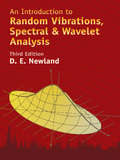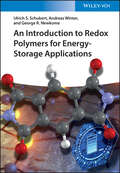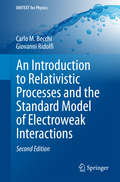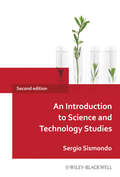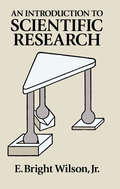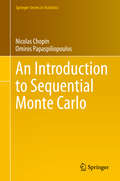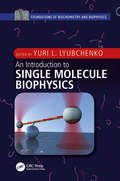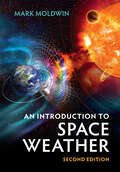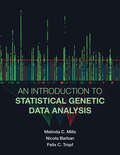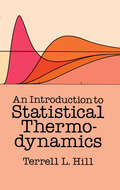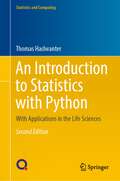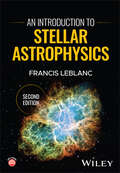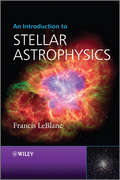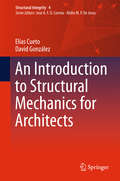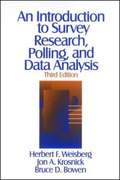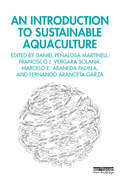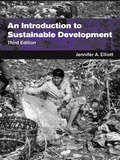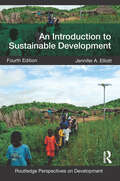- Table View
- List View
An Introduction to Radio Astronomy
by Bernard F. Burke Francis Graham-Smith Peter N. WilkinsonRadio astronomy is an active and rapidly expanding field due to advances in computing techniques, with several important new instruments on the horizon. This text provides a thorough introduction to radio astronomy and its contribution to our understanding of the universe, bridging the gap between basic introductions and research-level treatments. It begins by covering the fundamentals physics of radio techniques, before moving on to single-dish telescopes and aperture synthesis arrays. Fully updated and extensively rewritten, the fourth edition places greater emphasis on techniques, with detailed discussion of interferometry in particular, and comprehensive coverage of digital techniques in the appendices. The science sections are fully revised, with new author Peter N. Wilkinson bringing added expertise to the sections on pulsars, quasars and active galaxies. Spanning the entirety of radio astronomy, this is an engaging introduction for students and researchers approaching radio astronomy for the first time.
An Introduction to Random Vibrations, Spectral & Wavelet Analysis: Third Edition (Dover Civil and Mechanical Engineering)
by D. E. NewlandOne of the first engineering books to cover wavelet analysis, this classic text describes and illustrates basic theory, with a detailed explanation of the workings of discrete wavelet transforms. Computer algorithms are explained and supported by examples and a set of problems, and an appendix lists ten computer programs for calculating and displaying wavelet transforms.Starting with an introduction to probability distributions and averages, the text examines joint probability distributions, ensemble averages, and correlation; Fourier analysis; spectral density and excitation response relations for linear systems; transmission of random vibration; statistics of narrow band processes; and accuracy of measurements. Discussions of digital spectral analysis cover discrete Fourier transforms as well as windows and smoothing. Additional topics include the fast Fourier transform; pseudo-random processes; multidimensional spectral analysis; response of continuous linear systems to stationary random excitation; and discrete wavelet analysis.Numerous diagrams and graphs clarify the text, and complicated mathematics are simplified whenever possible. This volume is suitable for upper-level undergraduates and graduate students in engineering and the applied sciences; it is also an important resource for professionals.
An Introduction to Redox Polymers for Energy-Storage Applications
by Andreas Winter Ulrich S. Schubert George R. NewkomeAn Introduction to Redox Polymers for Energy-Storage Applications Presents a well-founded introduction to the field or Redox Polymers, with didactical features like summary boxes and a Q&A sections An Introduction to Redox Polymers for Energy-Storage Applications discusses fundamental aspects related to polymer-based batteries, such as types of batteries, their historic development, design and synthesis criteria of the active material, and summarizes the various types of redox polymers and their applications. Each chapter contains learning objectives, summary boxes, and questions to allow for efficient exam preparation. In An Introduction to Redox Polymers for Energy-Storage Applications, readers will find detailed information on: Fundamental aspects of redox-active polymers, along with their historical classification, taking the key applications of the materials into account Energy-storage devices, containing polymers as the electrode active materials, and specific material requirements for the desired applications Classification of redox-active polymers, e.g., according to the nature of the actual redox-active moieties, their backbone structure, or topology Electrical conductivity of conjugated polymers, covering their most prominent representatives (polyaniline, polypyrrole, polythiophene, and polyacetylene) An Introduction to Redox Polymers for Energy-Storage Applications also covers the synthesis and applications of these materials, making it an excellent book for graduates, PhD students, and professionals who are starting in this field.
An Introduction to Rehabilitation Engineering (ISSN)
by Hisaichi Ohnabe Douglas A. Hobson Rory A. CooperThis resource focuses on the principles, modeling, standards, devices, and technologies of rehabilitation engineering and assistive technology. It describes numerous design models and processes, including participatory action design and service delivery models. The book also discusses the components of devices such as cushions, wheelchairs, prostheses, orthoses, hearing aids, and TTYs. The contributors assess industry standards and explore innovative technology aids, such as sensors, robot-assisted therapy, and speech recognition software. The text contains a set of learning objectives and study questions in each chapter as well as a list of definitions at the end of the book.
An Introduction to Relativistic Processes and the Standard Model of Electroweak Interactions (UNITEXT for Physics)
by Carlo M. Becchi Giovanni RidolfiThis book offers a self-contained introduction to the theory of electroweak interactions based on the semi-classical approach to relativistic quantum field theory, with thorough discussion of key aspects of the field. The basic tools for the calculation of cross sections and decay rates in the context of relativistic quantum field theory are reviewed in a short, but complete and rigorous, presentation. Special attention is focused on relativistic scattering theory and on calculation of amplitude in the semi-classical approximation. The central part of the book is devoted to an illustration of the unified field theory of electromagnetic and weak interactions as a quantum field theory with spontaneously broken gauge invariance; particular emphasis is placed on experimental confirmations of the theory. The closing chapters address the most recent developments in electroweak phenomenology and provide an introduction to the theory and phenomenology of neutrino oscillations In this 2nd edition the discussion of relativistic scattering processes in the semi-classical approximation has been revised and as a result intermediate results are now explicitly proven. Furthermore, the recent discovery of the Higgs boson is now taken into account throughout the book. In particular, the Higgs decay channel into a pair of photons, which has played a crucial role in the discovery, is discussed. As in the first edition, the accent is still on the semi-classical approximation. However, in view of the necessity of a discussion of H !, the authors give several indications about corrections to the semiclassical approximation. Violation of unitarity is discussed in more detail, including the dispersion relations as a tool for computing loop corrections; the above-mentioned Higgs decay channel is illustrated by means of a full one-loop calculation; and finally, loop effects on the production of unstable particles (such as the Z0 boson) are now discussed. Finally, the neutrino mass and oscillation analysis is updated taking into account the major achievements of the last years.
An Introduction to Relativistic Quantum Field Theory
by Silvan S. Schweber"Complete, systematic, self-contained...the usefulness and scope of application of such a work is enormous...combines thorough knowledge with a high degree of didactic ability and a delightful style."--Mathematical ReviewsIn a relatively simple presentation that remains close to familiar concepts, this text for upper-level undergraduates and graduate students introduces the modern developments of quantum field theory. Starting with a review of the one-particle relativistic wave equations, it proceeds to a second-quantized description of a system of n particles, demonstrating the connection of this approach with the quantization of classical field theories. An examination of the restriction that symmetries impose on Lagrangians follows, along with a survey of their conservation laws. An analysis of simple models of field theories establishes the models’ content, and the problematic aspects of quantized field theories are explored.Succeeding chapters present the Feynman-Dyson perturbation treatment of relativistic field theories, including an account of renormalization theory, and the formulation of field theory in the Heisenberg picture is discussed at length. The book concludes with an account of the axiomatic formulation of field theory and an introduction to dispersion theoretic methods, in addition to a set of problems designed to acquaint readers with aspects of field theory not covered in the text.
An Introduction to Relativity
by Jayant V. NarlikarGeneral relativity is now an essential part of undergraduate and graduate courses in physics, astrophysics and applied mathematics. This simple, user-friendly introduction to relativity is ideal for a first course in the subject. Beginning with a comprehensive but simple review of special relativity, the book creates a framework from which to launch the ideas of general relativity. After describing the basic theory, it moves on to describe important applications to astrophysics, black hole physics, and cosmology. Several worked examples, and numerous figures and images, help students appreciate the underlying concepts. There are also 180 exercises which test and develop students' understanding of the subject. The textbook presents all the necessary information and discussion for an elementary approach to relativity. Password-protected solutions to the exercises are available to instructors at www. cambridge. org/9780521735612.
An Introduction to Science and Technology Studies
by Sergio SismondoAn Introduction to Science and Technology Studies, Second Edition reflects the latest advances in the field while continuing to provide students with a road map to the complex interdisciplinary terrain of science and technology studies. Distinctive in its attention to both the underlying philosophical and sociological aspects of science and technologyExplores core topics such as realism and social construction, discourse and rhetoric, objectivity, and the public understanding of science Includes numerous empirical studies and illustrative examples to elucidate the topics discussedNow includes new material on political economies of scientific and technological knowledge, and democratizing technical decisionsOther features of the new edition include improved readability, updated references, chapter reorganization, and more material on medicine and technology
An Introduction to Scientific Research
by E. Bright Wilson Jr.This book is intended to assist scientists in planning and carrying out research. However, unlike most books dealing with the scientific method, which stress its philosophical rationale, this book is written from a practical standpoint. It contains a rich legacy of principles, maxims, procedures and general techniques that have been found useful in a wide range of sciences.While much of the material is accessible to a college senior, the book is more specifically intended for students beginning research and for those more experienced research workers who wish an introduction to various topics not included in their training. Mathematical treatments have been kept as elementary as possible to make the book accessible to a broad range of scientists. Its principles and rules can be absorbed to advantage by workers in such diverse fields as agriculture, industrial and military research, biology and medicine as well as in the physical sciences.After discussing such basics as the choice and statement of a research problem and elementary scientific method, Professor Wilson offers lucid and helpful discussions of the design of experiments and apparatus, execution of experiments, analysis of experimental data, errors of measurement, numerical computation and other topics. A final chapter treats the publication of research results.Although no book can substitute for actual scientific work, this highly pragmatic compendium contains much knowledge gained the hard way through years of actual practice. Moreover, the author has illustrated the ideas discussed with as many actual examples as possible. In addition, he has included notes and references at the end of each chapter to enable readers to investigate particular topics more deeply. E. Bright Wilson, Jr. is a distinguished scientist and educator whose previous works include Molecular Vibrations and Introduction to Quantum Mechanics (with Linus Pauling). In the present book, he has distilled years of experiment and experience into an indispensable broad-based guide for any scientific worker tackling a research problem.
An Introduction to Sequential Monte Carlo (Springer Series in Statistics)
by Nicolas Chopin Omiros PapaspiliopoulosThis book provides a general introduction to Sequential Monte Carlo (SMC) methods, also known as particle filters. These methods have become a staple for the sequential analysis of data in such diverse fields as signal processing, epidemiology, machine learning, population ecology, quantitative finance, and robotics.The coverage is comprehensive, ranging from the underlying theory to computational implementation, methodology, and diverse applications in various areas of science. This is achieved by describing SMC algorithms as particular cases of a general framework, which involves concepts such as Feynman-Kac distributions, and tools such as importance sampling and resampling. This general framework is used consistently throughout the book.Extensive coverage is provided on sequential learning (filtering, smoothing) of state-space (hidden Markov) models, as this remains an important application of SMC methods. More recent applications, such as parameter estimation of these models (through e.g. particle Markov chain Monte Carlo techniques) and the simulation of challenging probability distributions (in e.g. Bayesian inference or rare-event problems), are also discussed.The book may be used either as a graduate text on Sequential Monte Carlo methods and state-space modeling, or as a general reference work on the area. Each chapter includes a set of exercises for self-study, a comprehensive bibliography, and a “Python corner,” which discusses the practical implementation of the methods covered. In addition, the book comes with an open source Python library, which implements all the algorithms described in the book, and contains all the programs that were used to perform the numerical experiments.
An Introduction to Single Molecule Biophysics (Foundations of Biochemistry and Biophysics)
by Yuri L. LyubchenkoThis book gives an accessible, detailed overview on techniques of single molecule biophysics (SMB), showing how they are applied to numerous biological problems associated with understanding the molecular mechanisms of DNA replication, transcription, and translation, as well as functioning of molecular machines. It covers major single molecule imaging and probing techniques, highlighting key strengths and limitations of each method using recent examples. The chapters begin with a discussion of single molecule fluorescence techniques followed by an overview of the atomic force microscope and its use for direct time-lapse visualization of dynamics of molecular complexes at the nanoscale, as well as applications in measurements of interactions between molecules and mechanical properties of isolated molecules and their complexes. The next chapters address magnetic tweezers and optical tweezers, including instrumentation, fundamentals of operation, and applications. A final chapter turns to nanopore transport and nanopore-based DNA sequencing technology that will play a major role in next-generation genomics and healthcare applications.
An Introduction to Space Weather
by Mark MoldwinOur space age technology enables global communication, navigation, and power distribution that has given rise to our 'smart', interconnected and spacefaring world. Much of the infrastructure modern society depends on, to live on Earth and to explore space, is susceptible to space weather storms originating from the Sun. The Second Edition of this introductory textbook is expanded to reflect our increased understanding from more than a dozen scientific missions over the past decade. Updates include discussions of the rapidly expanding commercial space sector, orbital debris and collision hazards, our understanding of solar-terrestrial connections to climate, and the renewed emphasis of human exploration of the Moon and Mars. It provides new learning features to help students understand the science and solve meaningful problems, including some based on real-world data. Each chapter includes learning objectives and supplements that provide descriptions of the science and learning strategies to help students and instructors alike.
An Introduction to Statistical Genetic Data Analysis (The\mit Press Ser.)
by Melinda C. Mills Nicola Barban Felix C. TropfA comprehensive introduction to modern applied statistical genetic data analysis, accessible to those without a background in molecular biology or genetics.Human genetic research is now relevant beyond biology, epidemiology, and the medical sciences, with applications in such fields as psychology, psychiatry, statistics, demography, sociology, and economics. With advances in computing power, the availability of data, and new techniques, it is now possible to integrate large-scale molecular genetic information into research across a broad range of topics. This book offers the first comprehensive introduction to modern applied statistical genetic data analysis that covers theory, data preparation, and analysis of molecular genetic data, with hands-on computer exercises. It is accessible to students and researchers in any empirically oriented medical, biological, or social science discipline; a background in molecular biology or genetics is not required.The book first provides foundations for statistical genetic data analysis, including a survey of fundamental concepts, primers on statistics and human evolution, and an introduction to polygenic scores. It then covers the practicalities of working with genetic data, discussing such topics as analytical challenges and data management. Finally, the book presents applications and advanced topics, including polygenic score and gene-environment interaction applications, Mendelian Randomization and instrumental variables, and ethical issues. The software and data used in the book are freely available and can be found on the book's website.
An Introduction to Statistical Thermodynamics (Dover Books On Physics Series)
by Terrell L. HillAlthough written on an introductory level, this wide-ranging text provides extensive coverage of topics of current interest in equilibrium statistical mechanics. Indeed, certain traditional topics are given somewhat condensed treatment to allow room for a survey of more recent advances.The book is divided into four major sections. Part I deals with the principles of quantum statistical mechanics and includes discussions of energy levels, states and eigenfunctions, degeneracy and other topics. Part II examines systems composed of independent molecules or of other independent subsystems. Topics range from ideal monatomic gas and monatomic crystals to polyatomic gas and configuration of polymer molecules and rubber elasticity. An examination of systems of interacting molecules comprises the nine chapters in Part Ill, reviewing such subjects as lattice statistics, imperfect gases and dilute liquid solutions. Part IV covers quantum statistics and includes sections on Fermi-Dirac and Bose-Einstein statistics, photon gas and free-volume theories of quantum liquids.Each chapter includes problems varying in difficulty — ranging from simple numerical exercises to small-scale "research" propositions. In addition, supplementary reading lists for each chapter invite students to pursue the subject at a more advanced level. Readers are assumed to have studied thermodynamics, calculus, elementary differential equations and elementary quantum mechanics.Because of the flexibility of the chapter arrangements, this book especially lends itself to use in a one-or two-semester graduate course in chemistry, a one-semester senior or graduate course in physics or an introductory course in statistical mechanics.
An Introduction to Statistics with Python: With Applications in the Life Sciences (Statistics and Computing)
by Thomas HaslwanterNow in its second edition, this textbook provides an introduction to Python and its use for statistical data analysis. It covers common statistical tests for continuous, discrete and categorical data, as well as linear regression analysis and topics from survival analysis and Bayesian statistics.For this new edition, the introductory chapters on Python, data input and visualization have been reworked and updated. The chapter on experimental design has been expanded, and programs for the determination of confidence intervals commonly used in quality control have been introduced. The book also features a new chapter on finding patterns in data, including time series. A new appendix describes useful programming tools, such as testing tools, code repositories, and GUIs.The provided working code for Python solutions, together with easy-to-follow examples, will reinforce the reader’s immediate understanding of the topic. Accompanying data sets and Python programs are also available online. With recent advances in the Python ecosystem, Python has become a popular language for scientific computing, offering a powerful environment for statistical data analysis.With examples drawn mainly from the life and medical sciences, this book is intended primarily for masters and PhD students. As it provides the required statistics background, the book can also be used by anyone who wants to perform a statistical data analysis.
An Introduction to Stellar Astrophysics
by Francis LeBlancAccessible and student-friendly textbook on the astrophysics of stars, now with new observational data and physical concepts An Introduction to Stellar Astrophysics is a concise textbook containing core content on and detailed examples of stellar physics and stellar astronomy. This new edition is revised and expanded and contains updated and new material on nearest and brightest stars, binary stars, Wolf Rayet stars and blue horizontal-branch stars, stellar evolution modeling and gravitational waves. The book is divided in seven chapters: basic concepts, stellar formation, radiative transfer in stars, stellar atmospheres, stellar interiors, nucleosynthesis and stellar evolution, and chemically peculiar stars and diffusion. Student-friendly features include detailed examples, exercises with selected solutions, brief recalls of the most important physical concepts, chapter summaries, and optional and advanced sections that can be skipped on first reading. A large number of graphs and figures are included to better explain the concepts covered. Only essential astronomical data are given, and the amount of observational results shown is deliberately limited in scope. An Introduction to Stellar Astrophysics includes information on: The electromagnetic spectrum, blackbody radiation, luminosity, effective temperature, the Boltzmann and Saha equations, and the Hertzsprung-Russell diagramHydrostatic equilibrium, the Virial theorem, the Jeans criteria, free-fall times, and pre-main-sequence evolutionRadiative opacities, specific intensity and radiative moments, local thermodynamic equilibrium, radiative transfer and stellar atmospheresEnergy transport in stars, polytropic models, stellar evolution, advanced nuclear burning, stellar remnants, and novae and supernovaeDiffusion theory, radiative accelerations, and other transport processesNew to this edition: sections on nearest and brightest stars, binary stars, the Eddington limit and stellar evolution modeling as well as several new special topics and additional exercises Delivering intermediate knowledge on stars in a concise format, An Introduction to Stellar Astrophysics is an excellent textbook on the subject for advanced undergraduate and graduate students studying physics and astrophysics.
An Introduction to Stellar Astrophysics
by Francis LeblancAn Introduction to Stellar Astrophysics aspires to provide the reader with an intermediate knowledge on stars whilst focusing mostly on the explanation of the functioning of stars by using basic physical concepts and observational results.The book is divided into seven chapters, featuring both core and optional content:Basic conceptsStellar FormationRadiative Transfer in StarsStellar AtmospheresStellar InteriorsNucleosynthesis and Stellar Evolution andChemically Peculiar Stars and Diffusion.Student-friendly features include:Detailed examples to help the reader better grasp the most important conceptsA list of exercises is given at the end of each chapter and answers to a selection of these are presented.Brief recalls of the most important physical concepts needed to properly understand stars.A summary for each chapterOptional and advanced sections are included which may be skipped without interfering with the flow of the core content.This book is designed to cover the most important aspects of stellar astrophysics inside a one semester (or half-year) course and as such is relevant for advanced undergraduate students following a first course on stellar astrophysics, in physics or astronomy programs. It will also serve as a basic reference for a full-year course as well as for researchers working in related fields.
An Introduction to Stochastic Processes in Physics
by Don S. LemonsThis book provides an accessible introduction to stochastic processes in physics and describes the basic mathematical tools of the trade: probability, random walks, and Wiener and Ornstein-Uhlenbeck processes. It includes end-of-chapter problems and emphasizes applications.An Introduction to Stochastic Processes in Physics builds directly upon early-twentieth-century explanations of the "peculiar character in the motions of the particles of pollen in water" as described, in the early nineteenth century, by the biologist Robert Brown. Lemons has adopted Paul Langevin's 1908 approach of applying Newton's second law to a "Brownian particle on which the total force included a random component" to explain Brownian motion. This method builds on Newtonian dynamics and provides an accessible explanation to anyone approaching the subject for the first time. Students will find this book a useful aid to learning the unfamiliar mathematical aspects of stochastic processes while applying them to physical processes that he or she has already encountered.
An Introduction to Stochastic Processes in Physics: Containing On The Theory Of Brownian Motion By Paul Langevin, Translated By Anthony Gythiel
by Don S. LemonsThis “lucid, masterfully written introduction to an often difficult subject . . . belongs on the bookshelf of every student of statistical physics” (Dr. Brian J. Albright, Applied Physics Division, Los Alamos National Laboratory).This book provides an accessible introduction to stochastic processes in physics and describes the basic mathematical tools of the trade: probability, random walks, and Wiener and Ornstein-Uhlenbeck processes. With an emphasis on applications, it includes end-of-chapter problems. Physicist and author Don S. Lemons builds on Paul Langevin’s seminal 1908 paper “On the Theory of Brownian Motion” and its explanations of classical uncertainty in natural phenomena. Following Langevin’s example, Lemons applies Newton’s second law to a “Brownian particle on which the total force included a random component.” This method builds on Newtonian dynamics and provides an accessible explanation to anyone approaching the subject for the first time. This volume contains the complete text of Paul Langevin’s “On the Theory of Brownian Motion,” translated by Anthony Gythiel.
An Introduction to Structural Mechanics for Architects (Structural Integrity #4)
by Elías Cueto David GonzálezThis textbook offers an introductory course to structural mechanics for architects, including problems and solutions. It follows a completely different approach to structural mechanics than the usual books for engineering schools, making it much more attractive for architecture students and practitioners. It also offers a different point of view for engineering students, as it provides them with a more intuitive understanding of structural mechanics and the models therein.Instead of studying the classical theory of linear elasticity and then particularizing it to simple structures, this book analyzes structures in a historic and also typological order. The book starts with cable structures and stone arches, followed by trusses and, finally, frame structures made of beams. For every typology, the latest, state-of-the-art theory in the field is introduced in a very didactic way.
An Introduction to Survey Research, Polling, and Data Analysis (3rd edition)
by Herbert F. Weisberg Jon A. Krosnick Bruce D. BowenExplains how surveys are conducted, how to read statistical reports, and how to analyze data, and provides guidelines for evaluating polls. Coverage includes understanding tables, interval statistics, survey design, sampling and question-writing, interviewing and coding strategies, analysis of different types of surveys, and reading and writing reports. Includes chapter exercises and answers. Paper edition (unseen), $25. 95. Annotation c. by Book News, Inc. , Portland, Or.
An Introduction to Sustainable Aquaculture
by Daniel Peñalosa Martinell Vergara-Solana, Francisco J Araneda Padilla, Marcelo E Fernando Aranceta GarzaThis new textbook provides an accessible introduction to sustainable aquaculture through its relationship with three key pillars: the environment, the economy, and society.As the demand for seafood keeps increasing, aquaculture is considered one of the most promising and sustainable ways to satisfy this demand with nutritious and high-quality food. It is important to understand, therefore, the wider role and impact aquaculture has on the environment, the economy, and society. The book begins by providing a foundational introduction to aquaculture and sustainability, discussing the complex and interdependent relationship that exists between the two. The core text of the book is divided into four parts which focus on the environment, economics, social impacts, and governance and technologies. Chapters examine key issues surrounding climate change, food security, new technologies, bioeconomics and risk analysis, international cooperation, employment, and animal welfare, with the book concluding with a chapter examining the future directions and challenges for the aquaculture industry. The book draws on global case studies and each chapter is accompanied by recommended reading and chapter review questions to support student learning.This book will serve as an essential guide for students of aquaculture, fisheries management, and sustainable food, as well as practitioners and policymakers engaged in sustainable fishery development.
An Introduction to Sustainable Development
by Jennifer ElliottThis third edition of a successful, established text provides a concise and well-illustrated introduction to the ideas behind, and the practices flowing from the notion of sustainable development.
An Introduction to Sustainable Development
by Jennifer ElliottThis third edition of a successful, established text provides a concise and well-illustrated introduction to the ideas behind, and the practices flowing from the notion of sustainable development.
An Introduction to Sustainable Development (Routledge Perspectives on Development)
by Jennifer ElliottThis fourth edition has been comprehensively rewritten and updated to provide a concise, well illustrated and accessible introduction to the characteristics, challenges and opportunities of sustainable development with particular reference to developing countries. The contested nature of sustainable development is explored through a detailed consideration of changing ideas and practices within environmentalism and development thinking. The text identifies the different actors involved (from institutions of global governance through to community based organisations), the policies and mechanisms through which sustainable development is being sought and considers the outcomes for particular groups and environments in both rural and urban contexts. ?? This edition places stronger emphasis on the global challenges of sustainable development with an understanding of inter-linked crises in climate, energy, economy, poverty and social injustice. It explores how these issues are leading to deep questioning of what sustainable development is, what it should be, and how sustainable development policies and mechanisms are being reconsidered. The book gives new consideration to the challenge of achieving lower carbon growth, climate adaptation, and the implications on sustainable development of rapidly expanding economies, including China and India. It contains greater discussion of how civil society movements influence outcomes of international climate policy, as well as technological developments in energy and agriculture. The text also contains a substantially expanded discussion of how poverty remains central to sustainable development challenges, as revealed through the Millennium Ecosystem Assessment and Millennium Development Goals. This invaluable text retains the core message that sustainable development has become central to debates about environment and development. Containing a substantial number of new boxed case studies, learning outcomes, chapter summaries, discussion questions, further reading and websites, this text provides an essential introduction for students.

